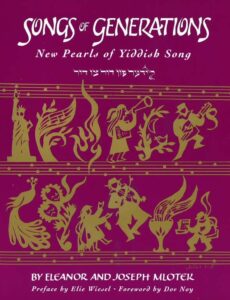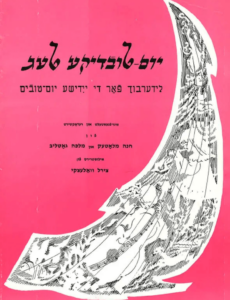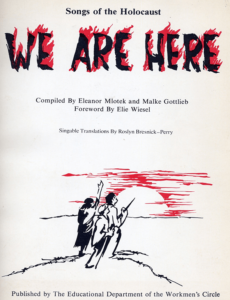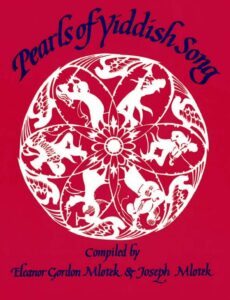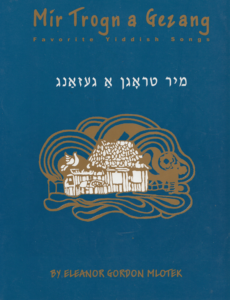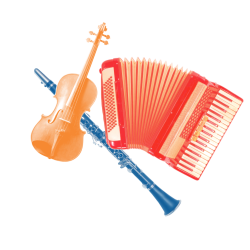Discover the Music
Browse through each song book or search the entire collection.
Search
A Brivele Der Mamen
This song, text and music by S. Shmulewitz (1868-1943) was one of the most beloved songs of the immigration era on both sides of the Atlantic.
A Glezele Yash
Text by the Soviet-Yiddish writer Yoysef Kerler, music by V. Shainsky. Kerler is the poet who was finally allowed to leave the Soviet Union after repeated public applications. He emigrated to Israel in 1971. His poems, which are an outright protest and denunciation of the Soviet Union’s treatment of the Jews, reached the United States and were published in the Jewish Daily Forward on September 20, 1970. This song is in the repertoire of the contemporary Soviet-Yiddish singer Nekhama Lifshitz, who settled in Israel in 1969.
A Grus Fun Di “Trentshes”
Song about the first World War, words and music by Isidor Lillian (1882-1960), published in 1918. The second stanza speaks of fighting for a Jewish homeland. The song was revived in the musical The Golden Land.
A Gut Purim
Adapted from Gavriel Tolye’s Purim Iz A Sphil Aza
A Gut-morgn, Feyge Soshe
Folksong published by Moishe Beregovski in 1962 and reprinted by Mark Slobin in Old Jewish Folk Music. Slobin notes that the humor in this song is enhanced by the interpolation of Russian rhyming words “giving a ‘highfalutin’ air.” Mascha Benya Matz submitted a slightly different version with an introduction and epilogue.
A Khazndl Oyf Shabes
Folk Song, published in 1918 by M. Kipnis. A favorite in the repertoire of many cantors.
A Kholem
Folk song (textual variant published in 1901 by S. Ginzburg and P. Marek; text and melody published in 1927 by Y.L. Cahan). The popular melody was used in the Soviet-Yiddish song “Baleytn, baleytn zaynen mir gegangen yunge prizivnikes in armey.” (We escorted recruits to the army).
A Kind A Goldene
Humorous song about the languages a Jewish child in Warsaw must speak. Words by the poet Avrom Reyzen (1875-1953). Originally titled “A bild fun di tsente yorn in varshe” (A picture of Warsaw in the 1910’s); In some collections the song is titled “Yorn dray-shprakhn fir” (Three years old-four languages). The song was sung by compiler Yosl Mlotek in Warsaw in the 1930’s.
Words and melody were published by Kh. Poznyak in 1974 in Tel Aviv. There the governess is English-speaking. A similar melody is used in Shmerke Kaczerginski’s 1948 collection of ghetto songs for the song “Tsvey brigades” (Two Brigades) by Leah Svirski.
A Malekh Veynt
Words and music by Peretz Hirshbein (1880-1948). Published in sheet music with Lazar Weiner’s arrangement by Jos. P. Katz, N.Y., 1921. In the Soviet-Yiddish anthology of Y. Dobrushin and A. Yuditski, it appears as an anonymous song with additional stanzas about the longings of a girl and boy for each other.
A Mizmer
A Mol Iz Geven A Mayse
Folk song. Text published in 1901 by S. Ginzburg and P. Marek; text and music published in 1911 by Platon Brounoff and S. Kisselgof. This folk song uses the metaphoric king and queen in referring to man and wife in keeping with Sabbath and Passover tradition.
A Mol Iz Geven A Yid
Words and music by Ben Yomen (1901-1970), published in the composer’s collection Oneg shabbat songs, 1962. The song, in the repertoire of popular singer Ben Bonus, was revived by his wife actress-singer Mina Bern, in the musical Those Were the Days. Bonus added the musical refrain.
A Nign
Words by L. Magister, pen name of Leibush Lehrer (1887-1965); music by Lazar Weiner (1897-1982). Published in sheet music by Transcontinental Music Corp., N.Y., 1940. This popular song is included in the repertoires of many concert and folk singers.
A Nigndl
Words by Shike Driz (1908-1971); music by Saul Berezovsky (1908-1975) and Josh Waletzky are presented. Joseph Schrogin also wrote music to the 1965 poem, entitled A nigndl (A Little Tune). Both the Waletzky and Berezovsky musical settings may be downloaded by PDF. Berezovky’s setting, entitled Dem zeydns nigndl (Grandfather’s Little Tune), includes a rearrangement of Driz’s text: for each verse, lines 5-8 of Shike Driz’s text are sung first, followed by lines 1-4. Josh Waletzky’s setting, entitled Dem zeydns nign (Grandfather’s Melody), was recorded by the composer on the album of new Yiddish songs, Vaserl, released in 1977.
A Pastekhl
Part of a song from the operetta Bar Kokhba (1883) by Abraham Goldfaden (1840-1908), founder of the modern Yiddish theatre. The shepherd here represents the Jewish people. The operetta led to the closing down of all Yiddish theatres in Russia by the Czarist government, on August 17, 1883, because of alleged revolutionary allusions.
A Sheyner Tog
Words by Jacob Adler (1873-1973) also known by his pen name bornKovner; composer unknown. The text was published in Abrasha Vayner’s collection Undzer gezang (Warsaw, 1930) with the title “Zikhroynes” (Memories). The words and music were printed in the Undzer gezang collection of 1947. According to compiler Yosl Mlotek and friends, it was popular in Poland in the 1930s. H. Ritterband also set the poem to music.
A Suke
From Suken Un Simkhes-toyre Published by “Oyfgang”, N. Y.
A Suke A Kleyne
A Yidish Kind
This song, of the Shauliai ghetto in Lithuania was written after the slaughter of children in the ghettos and concentration camps in March, 1943. The author Khane Kheytin Weinstein, was deported to the Stutthof concentration camp. She survived the war and lives in New York.
A Yingele, A Meydele
Published by A. Bulkin and L. Efron in 1917. Adapted from a folksong about the Jewish clergy: “Der rebele, der gabele; / Der khazndl, der shamesl / Gants kley-koydesh geyt dokh tantsn” (The rabbi, the trustee, the cantor, the sexton—the whole clergy is going dancing) published by Sussman Kisselgof in 1911.
The Bulkin-Efron version has the rabbi joining the dance. In the adaptation that Yosl Mlotek brings in his textbook Yidishe kinder, alef, 1971, it is the mother who is going to dance.
A Yor Nokh Der Khasene
Words by Isaac Reingold (1873-1903), popular song-writer of Chicago; the song was published in sheet music by S. Schenker and Son in 1913. It was also entitled Beser iz tsu blaybn a moyd (It Is Better to Remain a Maid) with lyrics by Reingold and music attributed to J. Rumshinsky. According to the published song in the Selected Songs and Poems of Reingold, 1952, the tune is called “Der rebes nigele” from the operetta Khokhmas noshim. The song spread to Eastern Europe and was included in the Soviet collection of Z. Skuditsky, 1936, as an anonymous song. S. Z. Pipe; Dov and Meir Noy, and other folklorists surmised that the song came from the theatre, without identifying the author or play. The melody appears as a “Frailach” in the Kammen International Dance Folio, no. 1, and as a “nign” in M. Beregovski, 1962 (no. 115).
Akhtsik Er Un Zibetsik Zi
Text and music by Mark Markovich Warshawsky (see note to Oyfn Pripetshik on page 2), originally titled Di Bobe Un Der Zeyde.
Ale Brider
This song is an adaptation of a poem by Morris Winchevsky (1856-1932), entitled “Akhdes” (Unity), in Di Kalekotke (The Rattle), published in Arbeter Fraynd Aug. 29, 1890.
Part of the original text reads: “Yo, mir zaynen ale eynik, tsu mir hobn fil tsu veynik. Un mir zaynen ale brider, un mir davnen fun eyn sider. . . Frum un link fareynikt ale, vi der khosn mit der kale, vi der khumesh mit di rashe, vi der kugl mit di kashe.” (Yes, we are all as one, whether we have much or little. And we are all brothers and pray from one prayer-book. . . Devout and leftist, united all, like the bridegroom and bride, like the Pentateuch with the Commentary, like pudding with porridge). In the 1920’s the folklorized song, much as we know it today, titled “Di Kalekotke,” was published as a folk song by the Yiddish writer and folklorist A. Litvin in Di Tsayt. Litvin notes that the song ”was the most popular folk song that was sung in the old country, mostly at Bundist parties. . . Each time it was sung something was added by each singer extemporaneously.”
Alef-indikes
Folksong which uses the Hebrew alphabet to humorously contrast the differences between rich and poor. Published by Menakhem Kipnis in 1925. The melody is based on the traditional Ashkenazic tune for the Akdomes poem. (see Max Wohlberg, “The Music of the Synagogue as a Source of the Yiddish Folk Song”). Kipnis has another tune with the Akdomes motive: “Alef-an odler tut untern himl flien” (A is for an eagle that flies beneath the sky).
Aleyn In Veg
Poem by M. Lermontov (1814-1841): “Vikhaihu odin ya na dorogu” was translated by Avrom Reyzen (1875-1953), music by E. Sashin. Published in sheet music by Joseph P. Katz in 1915. Numerous Yiddish translations of the Russian poem were printed in the Perl. The song was parodied by D. Apotheker in Di yidishe bine, N. Y., 1897: “Di shlekhte tsaytn” (The Hard Times) about the depression. Also Abraham Goldfaden’s song “Shtil un fintster iz di nakht in droysn” was contrafacted to the melody of Vikhazhu (printed in Sholem Aleichem’s’ Di yidishe folks-biblyotek, 1891).

